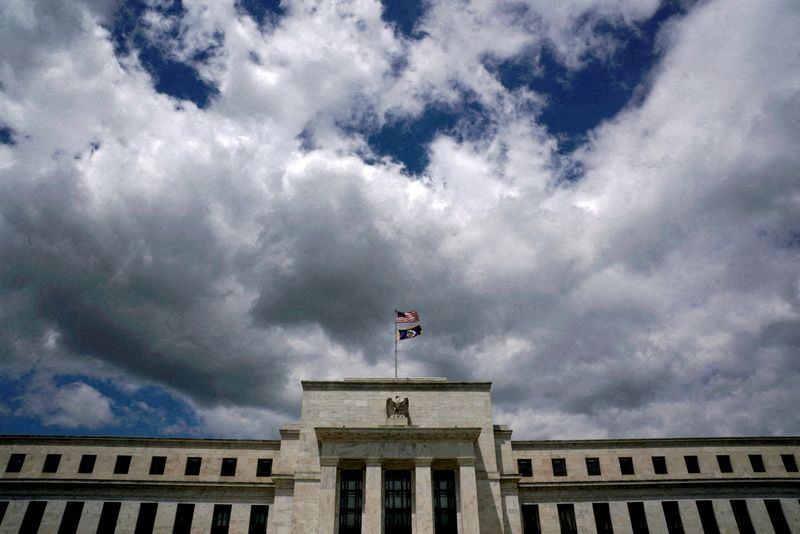By Paritosh Bansal
(Reuters) -The Fed is close to delivering a rare soft landing for the U.S. economy but it faces yet another fraught challenge: reducing cash in the financial system without disrupting markets.
With the Fed having already removed some $1.4 trillion as it shrinks its balance sheet to end pandemic-era support, the focus is increasingly turning to when it should stop. The worry is if cash in the banking system, called reserves, breach a certain minimum level, markets would freeze up. But no one knows what the right level is.
Last week, Fed Chair Jerome Powell said policymakers were nearing a decision to slow the pace of quantitative tightening (QT) to bring reserves "into a nice, easy landing." Powell said they are watching "a bunch of different indicators" in money markets to "to tell us when we're getting close."
The Fed's focus is comforting Wall Street, market participants said, even though the task before it is hard. It's difficult because the lines are blurry: the Fed is trying to go from "abundant" to "ample" reserves without making them scarce. And market signals to guide it are noisy and hard to discern.
Among the indicators the Fed is likely watching: bank reserves, some key interest rates in money markets and cash parked in the Fed's overnight reverse repurchase agreement facility, they said.
Mark Cabana, Bank of America's head of U.S. rates strategy, said it will be "quite a feat" for the Fed to engineer a soft landing, where the Fed leaves the right reserve levels in the banking system. But he added that he thought they had a "decent shot" now because they were taking a more accommodative stance.
"I would have told you last year, like in November-December, the Fed was very much at risk of missing it,” Cabana said.
He expects the Fed to announce tapering as early as May, reducing the cap on the amount of Treasuries it aims to offload every month by half to $30 billion. John Velis, Americas macro strategist at BNY Mellon (NYSE:BK), is of the same view on the size and timing of the taper.
It is important for the Fed to get the drawdown right, as a lack of reserves can cause sudden spikes in rates, disrupting Treasury markets and making it hard for firms to fund themselves. That could get tested in the coming weeks when along with QT, events such as the April 15 tax day would reduce cash in the financial system while increasing demand for it. So far, however, market functioning has held up.
In 2019, a spike in short-term funding rates forced the Fed to put reserves back into the system, something that Powell said the Fed does not want to test again, even though it has since set up a backstop to support money markets.
ABUNDANT RESERVES
Estimates of the minimum amount of bank reserves needed range from about $2.5 trillion to $3.3 trillion. Such reserves currently total about $3.5 trillion.
While they appear abundant, banks' need for cash has increased. Cabana noted that reserves had increased to $3.5 trillion from $3.3 trillion when QT started in the summer of 2022. He ascribed that to lenders adding reserves in the wake of deposit outflows after the bank failures in March 2023 and to unrealized losses in their securities portfolios.
In addition, distribution of reserves could vary by bank, making it harder to arrive at what's sufficient - a point that Powell acknowledged last week. "Aggregate reserves appear abundant, but it seems the Fed has an inkling that they are not well distributed across the system," BNY’s Velis said.
An indicator of excess cash is the Fed's reverse repo facility, where investors lend the central bank cash. That has been reducing, but the pace has slowed in recent weeks.
Views diverge on when that might completely drain and what it says about liquidity in the system. Velis expects it could go down to zero by the summer, while Cabana sees it not draining fully until the middle of next year. UBS strategists said it could rise in the second quarter at the expense of reserves.
MONEY MARKET INDICATORS
Among the indicators the Fed has said it is watching are two money market rates - the Fed funds rate at which banks lend to one another, and the benchmark Secured Overnight Financing Rate (SOFR) – in relation to the interest on reserve balances (IORB) that the Fed pays to banks.
Cabana expects the central bank would want the Fed funds to be about 10 basis points higher than where it is now, leaving it 2-3 basis points above the IORB. On SOFR, he expects the rate would need to go up 10-15 basis points higher, leaving it 0-5 basis points above what the Fed pays banks.
That's because total system cash is likely closer to ample levels when investors have to pay slightly above Fed administered rates to acquire it, Cabana said.
The rate would likely gradually rise as reserves fall, but in the interim supply-demand imbalances could cause brief rate spikes as it did in 2019 - signs for the central bank to watch.
"The Fed will be looking at both the rate and the volatility that is associated with that to determine when they actually need to stop QT,” Cabana said.
